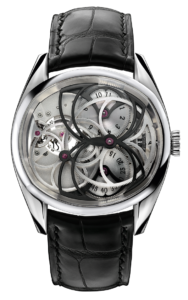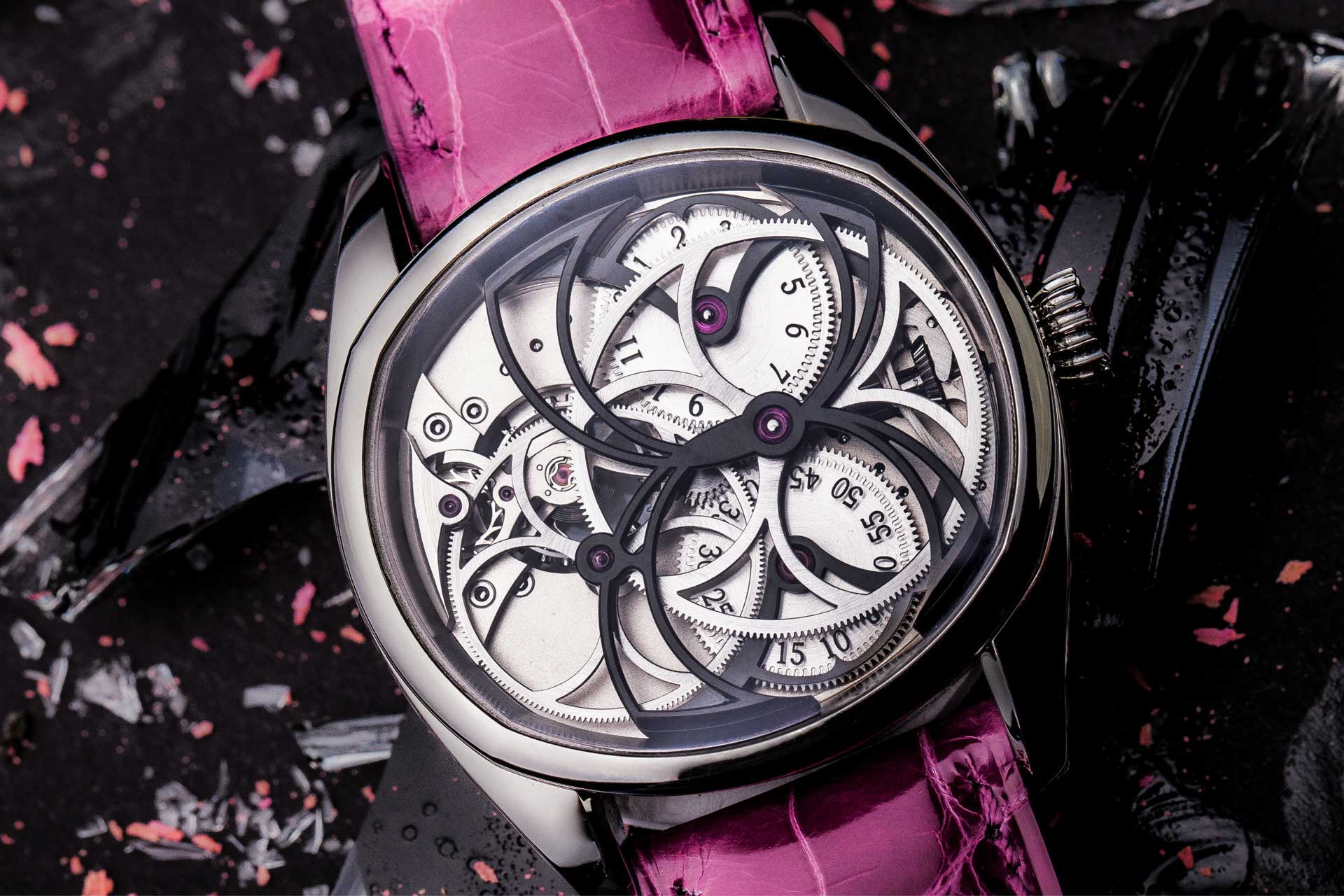In the beginning was the Papillon.
The Papillon was the first watch Andreas Strehler built under the sign of the butterfly. Already the Papillon has all the relevant elements which discern an Andreas Strehler Watch.
The „Papillon“ – the wristwatch as a living organism
In 2008, Andreas Strehler presented his own interpretation of an emotional watch-movement – the Papillon. His aim was to create a living organism that would hold the observer spellbound.
In contrast to many firms, Andreas Strehler regards his movements not as cold, technical machines but as living organisms whose elegance invite one to sense the time and the mechanics that generate it. He deals with the aesthetics of time without the necessary domination of ease of reading the dial. Sometimes he even runs counter to it. For example, it is possible to regard the cosmos of a Papillon as a mere mechanical marvel, the only function of which is to fascinate the beholder by the sight of the functioning movement.

Elegance begins with the construction of the movement
To create this fascination, Andreas Strehler developed a technical language of his own in the form of the Papillon. He drew his inspiration from the elegance of the technical progress of the late 19th century. In particular, it is the floral elements of the Art Nouveau, which perform basic functions in spite of their fragility that are to be found in the construction of the Papillon. Inspired by the art of traditional Swiss watch making, Andreas Strehler created his very own formal expression which makes the construction of his watch movements unique. First, he broke with the classical link between the main plate and the bridge, the dial and the movement side, since this would have had a restricting effect on his ideas.
His idea was to have a visible gear train allowing one to look deeply into the movement and see it working. The supporting elements were to be kept to a minimum, but they should have an aesthetic form to captivate the observer. Andreas Strehler needed no more than three wheels to create his idea of a living watch-organism. The time is almost hidden above the two barrels, ‘mystérieuse’ on two toothed glass discs, without the driving mechanism being visible.
The heart of the Papillon
The Papillon was constructed with the aim of producing a harmonious movement with original ideas which can show the time, but need not do so necessarily. The most important aspect was to be the harmony of the mechanics, the elegance and aesthetic of form and the interaction of the wheels which beat the time. And although the movement is composed of metal, it should appear as something from nature.
To achieve this, Andreas Strehler chose a totally new configuration for the construction of the movement, abandoning the traditional difference between the face and the back of the watch. By this apparent break with tradition, Andreas Strehler introduced new ideas without dispensing with the traditional craftsmen’s methods of decoration which underline optically the quality of his work. The bevelling in the internal edges was carried to the limit in the Papillon. Hardly any other watchmaker had dared to bevel such sharp edges by hand.
The movement is constructed in a different way to that of any other watch. Whilst Andreas Strehler is careful to construct his movement along classic lines, it must not be similar to movements of the past. That may sound like a contradiction in terms. But at a second glance, his movement appears as his own individual, modern interpretation of the traditional watchmakers’ craft.
For example, he manages without the classical main plate of a central plate with its various cut-outs. It was important for him to create an aesthetic movement. The elegance of the central plate is enhanced by Côtes de Genève and appears as a mainspring bridge, rather than the central element. And in order to stress the optical impression of an organically formed movement, Andreas Strehler opted for a central bridge in the shape of a butterfly.
The construction of the movement, its shape, follows the technical necessities. In this way the position of the two barrels and the balance-wheel form a basic slanted oval shape which corresponds with the shape of the watch-case.
The Papillon movement is a technical masterpiece. Its mechanics are reduced to the absolute minimum. For the Papillon, Andreas Strehler uses only three wheels for the transmission of power – the central wheel, the intermediate wheel and the escapement wheel. With its 192 teeth, the Papillon’s central wheel has what is probably the biggest gearwheel ever used in a wristwatch.
The shape of the central wheel and the intermediate wheel dominates the appearance of the Papillon. And this impression is increased by the smooth rounding of the bevelled wheels.
Although the Papillon movement appears very simple, it manifests a number of nice details which will please the hearts of everyone interested in mechanics.
The two barrels provide the Papillon with a guaranteed power reserve of 80 hours, although the energy stored in both barrels would enable a much longer power reserve. They are connected in parallel and thus guarantee smooth winding and the even action of the two mainsprings.
Besides the generous power reserve, the use of two barrels brings further advantages, for example the almost total elimination of bearing pressure on the central wheel – thus enabling optimal timekeeping precision.
„I wanted to make the mechanics and the function visible. This was to be my central concern, to make it understandable to the observer “, says Andreas Strehler.
A further special detail is the use of genuine conical gear wheels for the winding wheel and the winding pinion. As a result, these show no wear in the transmission of power and are therefore extremely long-lasting. In addition, their special gear tooth system enables the watch to be wound up smoothly and lightly.
With the Papillon, Andreas Strehler has certainly achieved one of his aims in watchmaking, namely to create a watch the wearer does not have to turn over to see the movement. What today is common, was then extraordinary.






